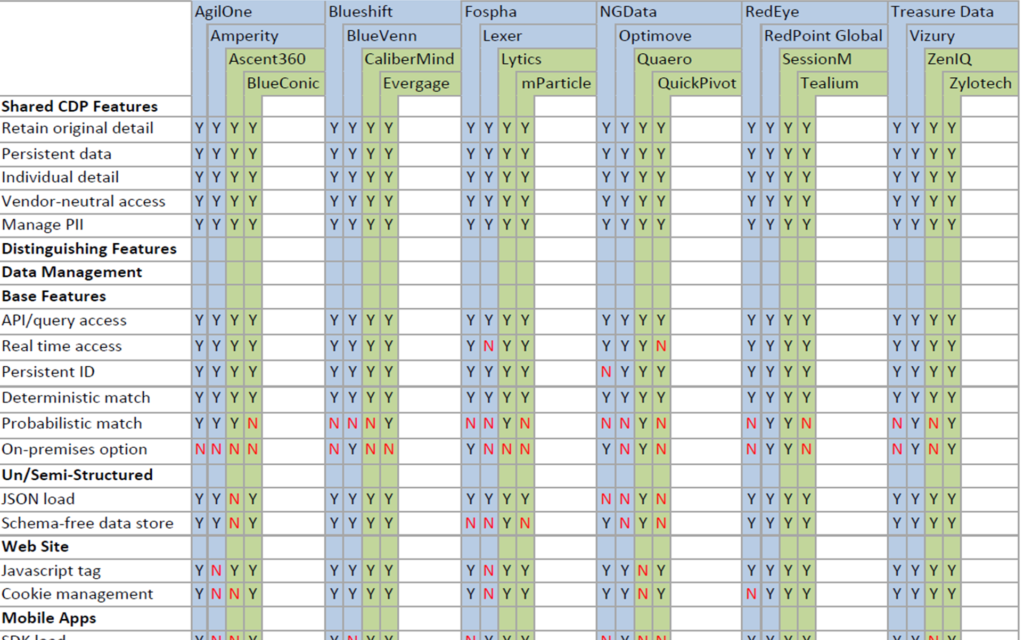The Customer Data Platform is an Essential Component of One-to-One Personalization
March 15, 2018Imagine you’re searching for information on a martech solution for your company. After doing a little research, you land on Company A’s website. Your goal is to quickly assess whether this solution is appropriate for your needs. But you find the homepage full of marketing language you can’t quite decipher and the navigation menu cluttered. There’s a lot of content on the site to sift through, and you’re having trouble working out whether Company A’s solution is right for you.
Then you land on Company B’s site. The homepage explains Company B’s unique selling proposition for your specific industry. It directs you to a whitepaper to answer some of your questions. From there, you are able to quickly locate case studies that show you how Company B was able to solve the problem you’re currently facing for other companies like yours. You leave the site feeling confident that Company B is a legitimate option for your team.
The difference between the two experiences is personalization, and it’s becoming an imperative for companies across industries. Companies like Netflix, Amazon and Spotify have made it clear that delivering personalized experiences is a critical business strategy, not just a marketing tactic. But it’s one thing to recognize the value of personalization; it’s another thing entirely to execute it successfully. For many organizations, what’s standing in the way of their execution of successful personalization is the data.
To create a great experience for a person, you must understand the person
Data is at the core of a great personalized experience. The more you know about a person, the more individualized and accurate the experiences you deliver will be. There are multiple different data sources that can potentially be used for personalization, depending on your business. Some of the key areas to focus on are:
● Web attributes such as geolocation, source (search, email, social, paid ad, referring site,
etc.), industry, company, company size (revenue or employee count), technology stack, time of day, and browser/device type
● Database attributes from CRM systems, email or marketing automation platforms, data warehouses, point-of-sale (POS) systems, call center solutions and other systems
● Site- or app-wide behavior such as number of site visits or logins, time spent per session, time elapsed since last visit, etc.
● Page visit behavior such as specific pages viewed and number of times viewed
● Campaign engagement such as personalized experience views and clickthroughs, email opens and/or clicks, push notification dismissals or clickthroughs, etc.
● Deep behavior such as time spent per page, mouse movement, scrolling, hovering, inactivity, etc. (to understand depth of engagement)
● Context of each visit or session based on metadata such as category, brand, price, author, topic, etc. (to understand what a person’s behavior says about his or her interests)
● Lifecycle stage such as first-time visitor, current prospect, regular customer, loyal advocate, potential churn risk, etc.
As you may have noticed, this is a lot of data. To complicate matters, this data often lives in silos across the organization — within CRM applications, email marketing solutions, web analytics tools and more. So even if it exists within the organization, it often can’t be used effectively. But with a Customer Data Platform (CDP), the organization can bring it all together in one place with a single profile for each individual person (and account for B2B companies). That single, comprehensive view of an individual or account is absolutely essential for personalization.
Of course, you need more than data alone
Once you have all this data, you need something that can effectively use it to deliver personalized experiences. Most importantly, you need:
Machine learning guided by humans: Machine learning helps you sift through the data and all the different experiences you could display to select the best one. Whether it’s selecting the best products, categories, brands, promotions, etc. to recommend to a visitor; reordering or changing the navigation to help her find what she’s looking for; sorting the search results to be relevant to her, etc., machine learning can make it possible.
Segmentation and rule-based targeting: While machine learning allows you to deliver personalized experiences at the individual level, there are still many opportunities to deliver experiences to segments via rule-based targeting. Any content or experience that is relevant to a specific industry, geolocation, persona, stage of the funnel, etc. can and should be delivered with rules.
Triggered messaging: Triggered messages allow you to send more timely content to prospects and customers across channels. For example, you can instantly send messages to specific customers; deliver experiences to particular visitors or users; send alerts or schedule tasks for internal stakeholders; or pass data to external systems – all based on a person’s behaviors, external factors like weather or geography, or even changes to product and content catalogs.
Real-time processing: All the data you collect is essentially useless if it can’t be used in real time to affect someone’s experience. You can’t rely on a person to return to your site or app; you need to be relevant immediately. So if someone on your travel site indicates that he’s researching ski vacations, you can’t wait until he returns to incorporate that intent into his experience.
Testing and attribution: Personalization is not something you can set and forget. You need to be able to test the effectiveness of each campaign, identify the impact it has on your business, and iterate to continue to improve your KPIs and the overall experience for each customer or prospect.
Final thoughts
Good data is absolutely essential to creating great personalized experiences for customers and prospects. But you need more than data alone. You need to consolidate lots of disparate information, interpret that information to make sense of it, and store it all in individual profiles that provide a complete picture of each person and company your organization interacts with. And all of this needs to be centralized and instantly actionable in a real-time capable CDP. Without such a CDP, your personalization strategy will be flawed. With it, you’ll be poised for success.
I wrote about Customer Data Platforms, machine learning, real-time processing, testing and much more in my recent book, One-to-One Personalization in the Age of Machine Learning. Download it for free on the Evergage website.


